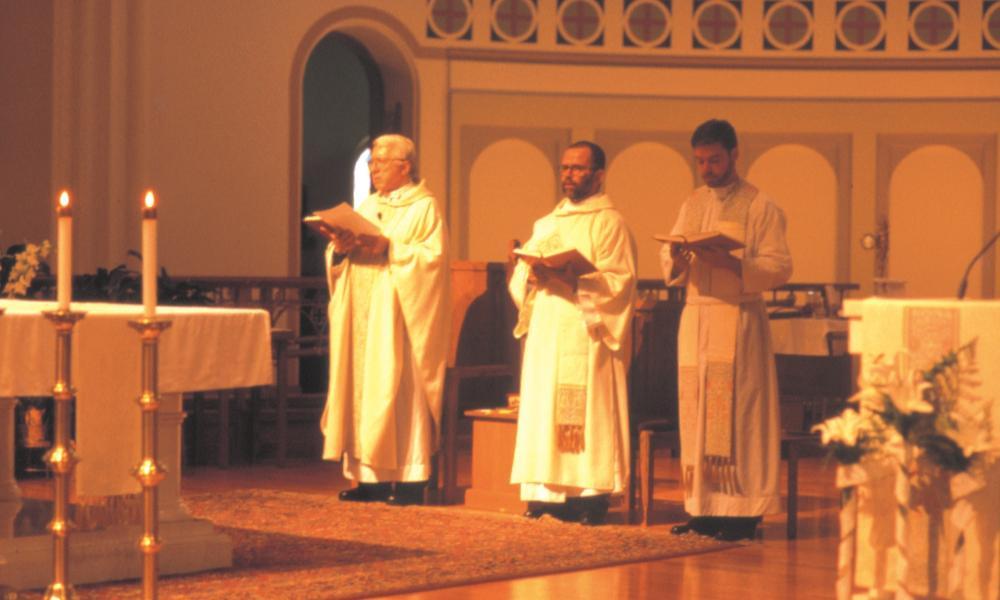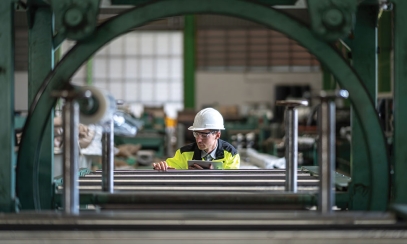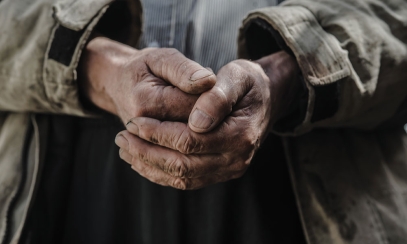
Liturgy: Part 2
What is the Liturgy? An Exploration of the Church’s Public Prayer.
What is the Liturgy? An Exploration of the Church’s Public Prayer.
Mass is the principal time the community gathers together. We join with our brothers and sisters to offer prayer, to encounter the Lord, to be in communion. This sense of community begins at the door of the church, or even on the steps outside. We greet each other, we extend hospitality to the stranger in our midst who is also one of us. This is a time for fellowship and welcoming.
Renewal of baptismal promises: As we enter, one of the first things we do is renew our first experience in the community of believers – we dip our hand into the baptismal font or a small container at the door that contains holy water – and we sign ourselves with the cross, speaking the very words spoken at our baptisms: “In the name of the Father and of the Son and of the Holy Spirit. Amen.”
Gathering song: When Mass is beginning, we sing a gathering song. Music is an important part of our celebration and we are encouraged to participate joyfully. We begin our prayer with a greeting and response between the presider and the assembly. The prayer that ends the opening rites is called the Collect – we collect together to praise the Lord.
Body of church gathered: Our call as we gather is to be the church – the people of God visibly witnessing to his presence among us. Jesus told us that where two or three (or 200 or 300) are gathered in his name, he would be there in our midst. This is what we live out when we come together at Mass – we make the body of Christ real and present
Penitential rite: One of the important things we are called to do as we assemble as a community is to be reconciled with each other. This is why a penitential rite occurs early in the Mass. We say the words of the ancient Greek prayer, “Kyrie, eleison. Lord, have mercy.” And often, we ask for our brothers and sisters to pray for us as we say, “I confess to almighty God and to you, my brothers and sisters, that I have sinned through my own fault.”
After we have gathered, asked forgiveness, praised God in the singing of the Gloria, we are ready to listen to the Word of God in the Scripture readings, which we’ll be discussing in the next issue.
Who’s in the sanctuary?
Priest: The priest, or presbyteros, is the person ordained to teach the faith, to preside over liturgy, to administer the sacraments. A priest may be attached to a specific area such as a diocese, or to a religious order. Diocesan priests submit to the authority of their bishop; religious priests to the head of their order. However, when working in a diocese, a religious priest is also subject to the local bishop.
Why do we do that?
The Sign of the Cross:
The sign of Christ’s cross is commonly traced from forehead to breast, from left shoulder to right in the Western church. In Eastern rites, the right shoulder is usually touched first. The symbolism is obvious, and the gesture originated with a small signing of the forehead, much as we do prior to the reading of the Gospel today, along with a signing of the lips and breast. This ‘little cross’ is also made on the book of the Gospels, the heads of those being baptized, and on the senses of those receiving the sacrament of the sick. The larger cross, with which we are most familiar, appears to have developed as people began using two and then three fingers, in order to symbolize the natures of Jesus and the Trinity.
What’s the season?
Lent:
Lent is the penitential season leading up to Easter. During Lent, we fast, pray and give alms. It arises from the 40-day baptismal retreat experienced by catechumens in the early church. We, too, prepare to renew our baptismal promises at the Easter Vigil Mass. Lent begins on Ash Wednesday and ends just before the Mass of the Lord’s Supper on Holy Thursday. The liturgical color for Lent is purple.
What’s he wearing?
Alb:
The alb is the first vestment the priest dons when getting ready for Mass. It is an ankle-length white garment with long sleeves. The name originates from the word alba, meaning white. The alb is a symbol of our baptism and is not reserved for priests – it may be worn by anyone who is engaging in a liturgical role.
What’s in the church?
A Cross/Crucifix:
At every Mass, there is a cross on or near the altar, clearly visible to the congregation. This cross must have the figure of the crucified Christ on it – in other words, it must be a crucifix. The purpose of the crucifix is to remind us of the paschal mystery – the passion, death and resurrection of Jesus Christ.



